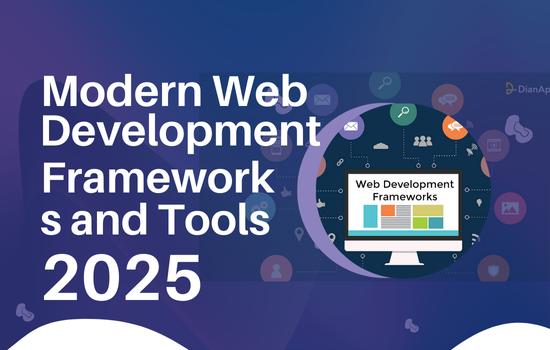In the fast-changing world of web development, staying updated with the latest frameworks and tools is essential. These technologies make it possible to create websites and applications that are fast, scalable, and user-friendly. By 2025, some frameworks have become very popular among developers and businesses that focus on web development services. Here’s a simple overview of the main frameworks that are leading in the web development world right now.

What are the main frameworks and tools currently dominating the industry?
High Performance Frontend Frameworks For Building the User Interface
1. React (Next.js)
React remains the most widely adopted UI library, known for its component-based architecture and efficient virtual DOM. In 2025, its real power comes from Next.js 15, which extends React into a full-stack framework with built-in server-side rendering (SSR), API routes, and edge deployment support.
Why is it popular?
- Massive ecosystem of libraries, tooling, and community support.
- Flexibility for both small projects and large enterprise applications.
New/Upcoming features:
- React Server Components (RSC) in Next.js 15 let developers render components on the server, sending less JavaScript to the browser → faster, lighter apps.
- Streaming & Suspense: Faster load times and better Time-to-Interactive (TTI)
- Turbopack integration: Rust-powered bundler that’s dramatically faster than Webpack.
2. Svelte (and SvelteKit)
Unlike React or Angular, Svelte compiles code at build time into optimized vanilla JavaScript. This eliminates the runtime overhead, resulting in smaller bundles and faster performance.
Why it’s popular?
- Minimal boilerplate, fast rendering, and simplicity.
- Ideal for performance-critical apps (dashboards, media-heavy apps, mobile-first apps).
New/Upcoming features:
- Svelte 5 “Runes”: A new reactivity model simplifying state management.
- SvelteKit: Matured into a robust full-stack framework with SSR, SSG, and API endpoints.
3. Vue 4
Vue sits between React’s flexibility and Angular’s structure, making it a progressive framework that scales easily.
Why it’s popular?
- Favored in Asia and Europe, strong in startups and mid-sized companies.
- Intuitive single-file components (HTML, CSS, JS in one file)
New/Upcoming features:
- Stronger TypeScript integration for enterprise apps.
- Improved reactivity system for faster rendering and better memory management.
- Enhanced Composition API for reusable code.
Backend Frameworks: Powering Servers and APIs
1. Node.js & Bun
Node.js is a widely used runtime for building web application backends with JavaScript, allowing developers to use the same language on both frontend and backend. It remains popular for API development. Bun is an emerging alternative that serves as a runtime, bundler, and test runner, attracting early adopters and startups due to its speed and simplicity, while teams preferring a mature ecosystem continue to use Node.js.
Why it’s popular?
- Node.js powers millions of APIs globally.
- Bun offers speed, built-in TypeScript support, and fewer external dependencies.
New/Upcoming features:
- Bun: Native bundling, testing, and TypeScript support.
- Node.js: Continued improvements in ECMAScript modules (ESM) and performance.
2. Django (Python)
Django is a popular Python framework for building websites, known for its simplicity and clarity. It includes many built-in features, such as an ORM, admin panel, authentication, and security measures. Django accelerates development time and is trusted for applications requiring strong security and compliance.
Why it’s popular?
- Still the top choice for banks, healthcare, and government apps.
- Mature ecosystem with strong community support.
New/Upcoming features:
- Async features for real-time applications.
- Stronger cloud-native integration for scalable deployments.
3. FastAPI (Python)
FastAPI is a modern Python framework that prioritizes asynchronous programming and automatically generates OpenAPI/Swagger documentation. It enhances developer productivity by reducing boilerplate code and providing built-in documentation, making it ideal for AI-driven backends.
Why it’s popular?
- Perfect for AI/ML-driven backends in Python ecosystems.
- Delivers fast, production-ready APIs.
New/Upcoming features
- Better async tooling for scaling microservices.
- Seamless integration with GraphQL and modern frontends.
4. Spring Boot (Java)
Spring Boot is essential for Java enterprise development, offering a comprehensive ecosystem for APIs, microservices, and enterprise applications. It is particularly valuable for enterprise workloads due to its long-term stability and support.
Why it’s popular?
- Huge ecosystem for enterprise workloads.
- Strong in finance, insurance, and large SaaS platforms.
New/Upcoming features
- GraalVM native compilation for faster startup and lower memory.
- Deeper integration with Kubernetes and cloud-native systems.
Full-Stack Frameworks
1. Next.js (React) & Remix
Next.js combines frontend and backend development, offering features like Server Components, edge rendering, and API routes, making it a full-stack solution for React. In contrast, Remix emphasizes server-centric rendering and progressive enhancement, catering to teams seeking faster backends with reduced JavaScript usage.
Why it’s popular?
- Next.js: Default full-stack choice for React developers.
- Remix: Lightweight, server-first option.
New/Upcoming features
- Next.js 15: Server Components, Turbopack, streaming, and full edge support.
- Remix: Native serverless deployments and tight integration with Web Fetch API.
2. Nuxt 4 (Vue)
Nuxt is a meta-framework for Vue, similar to Next.js for React, providing routing, SSR, and serverless deployments. It is utilized by Vue developers for enterprise scalability and SEO-friendly applications.
Why it’s popular?
- Ideal for startups and mid-sized teams.
- Offers SEO-friendly rendering and scalability.
New/Upcoming features
- Hybrid rendering (mix static, SSR, edge functions).
- Vue 4 + TypeScript support.
Why These Tools Matter in 2025?

Choosing the right framework impacts your app’s speed, scalability, maintainability, and developer productivity. The top frameworks today represent a balance between performance, developer experience, and strong community support. Alongside this, web development trends are shaping how these frameworks evolve and how developers build more secure, faster, and user-friendly applications.
Many companies adopt hybrid approaches or combine different tools to build solutions tailored to their unique needs, keeping pace with trends such as Progressive Web Apps (PWAs), AI-powered development tools, and serverless architectures. Collaborating with a UI UX design agency can also enhance user experience and ensure designs align with current best practices. Staying aligned with these trends ensures that your projects remain modern, efficient, and competitive.
Wrapping Up
Performance & Efficiency: Svelte, Vite, Bun deliver blazing-fast UX and builds.
Scalability & Productivity: Next.js, FastAPI, PlanetScale support enterprise-grade, flexible development.
AI-Supported Workflows: Copilot X and Cursor IDE are transforming how we write, test, and optimize code.
Future-Ready Stacks: Developers must pick tools that adapt to cloud, real-time, and serverless-first environments.

Senior Front-End Developer at Fegno Technologies with 5+ years of experience crafting clean, responsive, and scalable web applications. Specialized in React.js, Next.js, JavaScript, HTML5, and CSS3, turning complex ideas into seamless digital experiences. Passionate about UI/UX excellence, performance optimization, and modern web technologies.

 Schedule An Appointment
Schedule An Appointment